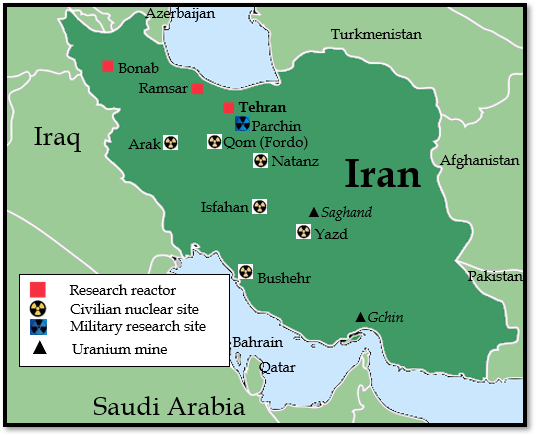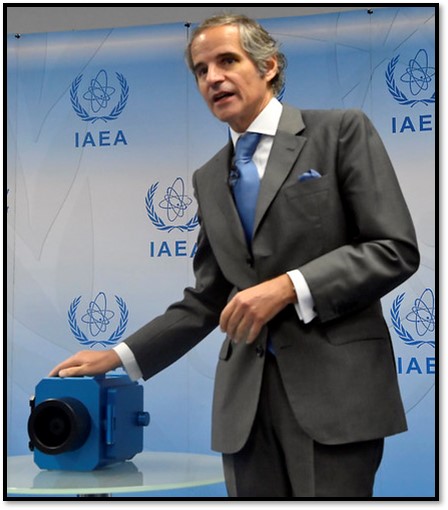Kelsey Davenport is the Director for Nonproliferation Policy at the Arms Control Association.
What actions did Iran take in 2022 to advance its nuclear program? How did Iran’s nuclear capabilities change in 2022?
Iran significantly expanded its uranium enrichment program in 2022. One of the most concerning developments was the accelerated installation of advanced centrifuges, the cylindrical machines that enrich uranium to fuel either nuclear weapons or nuclear reactors. Iran was limited to producing enriched uranium using IR-1 centrifuges—early and inefficient models that are prone to crash—under the 2015 nuclear deal known as the Joint Comprehensive Plan of Action (JCPOA). In 2022, Iran more than doubled the number of installed IR-2 centrifuges. The IR-2 is about three to four times as efficient as the IR-1. Iran also more than tripled the number of installed IR-6 centrifuges, which can be up to six times more efficient than the IR-1.
The installation and operation of advanced centrifuges means that Iran can enrich uranium much faster. It has gained valuable knowledge along the way about how to produce and operate the advanced machines, which cannot be reversed even if the JCPOA is revived and the advanced centrifuges are dismantled.

Iran also increased its separate stockpiles of highly enriched uranium to 20 percent or 60 percent purity. (Under the JCPOA, it was allowed to enrich uranium to only 3.67 percent. Uranium enriched to 90 percent or higher is considered weapons-grade.) The higher percentage of purity means that Iran could enrich uranium to weapons-grade levels more quickly than if it started with uranium enriched to 3.67 percent.
In November 2022, Iran started enriching uranium to 60 percent at Fordo. Iran was already enriching to that level at Natanz, a facility near Isfahan. The area at Natanz where uranium is being enriched to 60 percent is above ground and vulnerable to attack. The decision to enrich to 60 percent at Fordo represents a greater proliferation risk because it is buried deep under the mountains near Qom. A military strike to disrupt Iran’s nuclear activities at Fordo would be far more difficult.
But assessing the entirety of Iran’s advances, particularly its inventory of advanced centrifuges, is hard because inspectors with the International Atomic Energy Agency (IAEA)—the U.N. nuclear watchdog—lost access to certain facilities, including Iran’s centrifuge production workshops in 2021. And in 2022, Iran opened a new and larger one at Natanz that the IAEA has never inspected.
Why did Iran take these actions? Were they a response or an initiative?
Tehran views advancing its nuclear program as leverage over the United States and other adversaries. The government has repeatedly warned that it will continue to respond to foreign pressure or perceived provocations by ratcheting up nuclear activities. Its first breaches of the JCPOA in 2019 followed President Trump’s decision to withdraw the United States from the nuclear deal and reimpose sanctions in a “maximum pressure” campaign.
 In June 2022, Iran announced the installation of two new cascades of IR-6 centrifuges at Natanz after the IAEA Board of Governors passed a resolution censuring Iran for failing to explain uranium traces found at three locations in 2018 and 2019 but linked to work done before 2003. Iran also removed 27 cameras where the IAEA was monitoring various aspects of its nuclear program and the monitors that tracked enrichment levels in real time.
In June 2022, Iran announced the installation of two new cascades of IR-6 centrifuges at Natanz after the IAEA Board of Governors passed a resolution censuring Iran for failing to explain uranium traces found at three locations in 2018 and 2019 but linked to work done before 2003. Iran also removed 27 cameras where the IAEA was monitoring various aspects of its nuclear program and the monitors that tracked enrichment levels in real time.
In November 2022, Tehran announced plans to install more IR-6 centrifuges and enrich uranium to 60 percent at the Fordo facility after the IAEA Board again censured Iran for refusing to account for the nuclear materials at the three undeclared sites, as required by Nonproliferation Treaty (NPT) safeguards obligations. Iran was one of the 62 original signatories to the NPT in 1970 and is legally obligated to implement NPT requirements irrespective of the status of the JCPOA.
What do the advances mean for Iran’s nuclear program? How do they change the breakout time to get enough weapons-grade uranium for a bomb?
Iran’s expansion of its uranium enrichment program drastically shortened its breakout time. When Iran was fully complying with the JCPOA between 2016 and 2019, the breakout time was about 12 months. By late 2022, breakout time was down to less than a week, raising the risk that Iran could attempt to breakout between inspections.
Under the JCPOA, IAEA inspectors had daily access to Natanz and Fordo. But Iran curtailed access in February 2021 after the assassination of Mohsen Fakhrizadeh, the father of Iran's pre-2003 nuclear weapons program, in 2020. In response to the assassination, Iran’s parliament passed a law requiring the government to accelerate its nuclear program and reduce monitoring if Iran did not receive the economic benefits promised by the JCPOA. The law required Iran to start using 1,000 new IR-6 centrifuges by the end of 2021 (a benchmark only met in 2022). The law also mandated Atomic Energy Organization of Iran to stockpile more uranium enriched to 20 percent.
More troubling, Iran’s advances mean that it could produce enough uranium to fuel three or four weapons in about a month if it made the political decision to build a bomb. (Other steps are required to actually make a useable bomb.) The ability to produce enough material for multiple weapons quickly increases the proliferation risk because one bomb does not provide an effective deterrent. Detecting and disrupting covert weaponization efforts would be more difficult if Iran dispersed its weapons-grade material to multiple locations.
How important is enriched uranium to Iran’s nuclear program?
Iran has a civil nuclear program that includes a nuclear power reactor and a research reactor, which produces isotopes for medical treatments. A second research reactor is under construction, and Rosatom, the Russian nuclear energy corporation, is building additional nuclear power reactors.
But Iran’s nuclear fuel requirements are being met by international suppliers. Rosatom has a long-term contract to fuel Iran’s current and planned power reactors, and the JCPOA requires that the world’s six majors powers–Britain, China, France, Germany, Russia, and the United States–assist Iran in obtaining the uranium fuel enriched to 20 percent for its research reactor. There is no legitimate, civil justification to enrich uranium to 20 percent or 60 percent or even to stockpile large quantities of uranium enriched to 5 percent. Iran is using its enrichment capabilities at least in part to pressure the United States to rejoin into the JCPOA in exchange for lifting sanctions.
How far advanced is Iran’s enrichment? How large is Iran’s current stockpile of enriched uranium? And what is the breakdown on the various levels of enrichment—from 2 percent to 60 percent?
As of 2022, no other nation without a nuclear weapon was enriching to 60 percent. Enriching uranium to 60 percent purity, which is very close to weapons-grade of 90 percent, is a serious proliferation risk. As of November 2022, Iran had produced 62 kg of uranium enriched to 60 percent, which it would need to feed through centrifuges again to reach 90 percent. About 42 kg of uranium enriched to 60 percent would produce enough 90 percent enriched uranium for a bomb.

What additional steps would Iran need to take to produce a nuclear weapon if it made the political decision to make a bomb? How long might it take to get there?
Enriching enough uranium for a bomb is just the first step in producing a weapon. The uranium, in gas form, would need to be converted into a metal and then shaped to fit in a warhead. The uranium metal would also need to be fitted with an explosive package and then married with a delivery system, such as a missile. Iran apparently intended to deliver nuclear warheads using ballistic missiles, according to documents analyzed by the IAEA and to U.S. intelligence community assessments.
Israeli military officials reported that the weaponization process would take a year or two. Technically, however, Iran could probably produce a crude weapon in less than year. The weaponization process could take place at relatively small facilities that would be easier to hide from foreign intelligence. In contrast, uranium enrichment facilities are typically large sites that are not easy to conceal.
What are the outstanding issues between Iran and the IAEA, the U.N. nuclear watchdog?
Iran is obligated to account for its nuclear materials under legally binding provisions of its Comprehensive Safeguards Agreement (CSA). As an NPT member state, Iran is required to implement a CSA to demonstrate that the program is entirely peaceful. In 2018, the IAEA opened a new investigation into evidence provided by Israel that Iran had not declared all of its nuclear activities and materials from its pre-2003 nuclear weapons program.

IAEA inspectors probed four locations. They visited three of the sites and detected traces of processed uranium, which indicated that Iran violated the CSA. Iran subsequently stonewalled the investigation and has refused to provide credible explanations for the uranium, despite two resolutions censuring Tehran. But the IAEA has no enforcement mechanisms. The IAEA’s Board of Governors would have to refer Iran to the U.N. Security Council for any punitive action, such as new international sanctions.
What facilities or capabilities is the IAEA no longer able to monitor and inspect in 2022?
In 2022, the IAEA still had regular access to facilities where nuclear material is present, including the Natanz and Fordo facilities, the Tehran Research Reactor, and the Bushehr reactor. But in 2021, as a result of the 2020 nuclear law, the IAEA lost access to some facilities relevant to Iran’s nuclear program that are not covered under its CSA because they do not contain nuclear materials. Those facilities include centrifuge production sites, the heavy water production site, and uranium mines and mills.
Could Iran be hiding a secret capability or undeclared facility from the outside world?
In 2022, the U.S. intelligence community reported that Iran did not appear to have resumed key weaponization activities. In November, IAEA Director General Rafael Mariano Grossi also said that there was no evidence of weaponization work. Iran, however, could be hiding an undeclared facility or trying to divert materials for undeclared activities. Iran has covertly constructed facilities in the past, including at Natanz and Fordo. But U.S. and Israeli intelligence have strong track records in detecting covert activities in Iran. So constructing a secret facility would be very risky for Tehran.
Photo Credits: Photo Credits: Centrifuges via Mashregh News; Grossi via Dean Calma / IAEA (CC BY 2.0)
